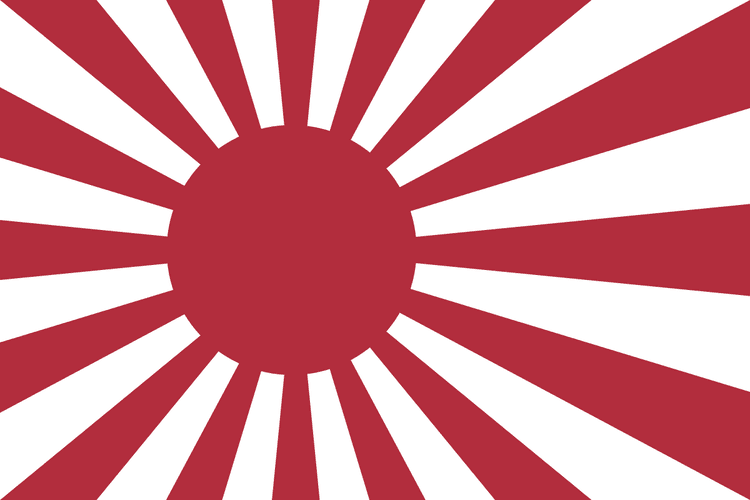 | ||
The Rising Sun Flag (旭日旗, Kyokujitsu-ki) design was originally used by feudal warlords in Japan during the Edo period. On May 15, 1870, as a policy of the Meiji government, it was adopted as the war flag of the Imperial Japanese Army, and on October 7, 1889, it was adopted as the naval ensign of the Imperial Japanese Navy. It is still used in Japan as a symbol of tradition and good fortune, and is incorporated into commercial products and advertisements. The flag is currently flown by the Japan Maritime Self-Defense Force and a modified version is flown by the Japan Ground Self-Defense Force. It is viewed as a symbol associated with Japanese imperialism in the early 20th century in South Korea, North Korea, China, and by some veterans in the United States because of its use by Japan's military forces during that period.
Contents
Design
The design is similar to the flag of Japan, which has a red circle in the center signifying the sun. The difference compared to the flag of Japan is that the Rising Sun Flag has extra sun rays (16 for the ensign) exemplifying the name of Japan as "The Land of the Rising Sun". The Imperial Japanese Army first adopted the Rising Sun Flag in 1870. The Imperial Japanese Army and the Imperial Japanese Navy both had a version of the flag; the naval ensign was off-set, with the red sun closer to the lanyard side, while the army's version (which was part of the regimental colors) was centered. The flag was used until Japan's surrender in World War II during August 1945. After the establishment of the Japan Self-Defense Forces in 1954, the flag was re-adopted and approved by the GHQ. The flag with 16 rays is today the ensign of the Maritime Self-Defense Force while the Ground Self-Defense Force uses an 8-ray version.
Present-day use
The Rising Sun Flag appears on commercial product labels, such as on the cans of one variety of Asahi Breweries lager beer. The design is also incorporated into the logo of the Japanese newspaper Asahi Shimbun. Among fishermen, the tairyō-ki (大漁旗, Good Catch Flag) represents their hope for a good catch of fish. The flag is also used at sporting events by the supporters of Japanese teams. Some extreme right-wing groups display it at political protests. The flag is also used by non-Japanese, for example, in the emblems of some U.S. military units based in Japan, and by the American blues rock band Hot Tuna, on the cover its album Live in Japan.
Issues regarding the flag in China and South Korea
Due to the flag being used by the Imperial Japanese military and Japan's actions during World War II, many Koreans, whose country had been oppressed under Japanese rule, and Chinese find the flag to be offensive. Because of this, the use of the flag is considered to be controversial. Although they complain about the rising sun flag, no country prohibits from using it by law. Moreover, the South Korean Navy's position is that there are no problems with the carrying of the rising sun flag by the Japan Maritime Self-Defense Force warships. It would be an infringement of sovereignty if the Korean Navy requested to not carry the rising sun flag. Even China and South Korea, the countries that most often condemn the rising sun flag have hardly ever remarked about the use of the flag before the 2000s. In 2013, Sohn Yin-Choon (손인춘), a member of the Congress in South Korea finally insisted that a law about the rising sun flag should be instituted.
